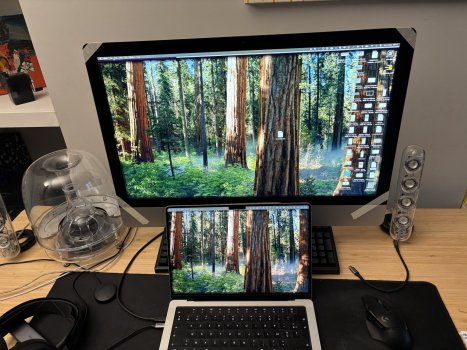@ItsAShaunParty
"Where did you get the board/crossovers, etc? That seems very affordable."
@VegetarianNachos posted this in his build description:
- 'An R1811 v4 driver board from StoneTaskin which came with:
- an LCD cable
- a backlight cable
- an OSD keypad
- a 24V, 5A power supply
- and a remote
- A set of crossover boards to utilize the iMac speakers purchased from StoneTaskin'
Links to StoneTaskin's website. Prices include delivery charges:
R1811
older version (5K with DP/USB-C and HDMI 2.0 4K) and original 04 firmware.
R1811
newer version? with HDMI 2.0 (5K with DP/USB-C and HDMI 4K).
R1811
latest version HDMI 2.1 (5K with DP/USB-C and HDMI 5K) with new firmware.
[All AliExpress and eBay vendors of the R1811 seem to be selling the older version.]
StoneTaskin also sells the JRY-W9RQUHD-SA1 board:
To create a good consumer experience, please confirm your LCD/LED Screen part number before ordering. If you're a wholesale/distributor in your country please contact us for a better price and the best logistic options Please feel free to ask any questions about the product Every order is...

stonetaskin.com
Crossover kit YLY-2088x2:
StoneTaskin High-Quality Treble & Bass Speaker Crossover Divider Compatible Models: iMac 27-Inch A1219 / A2115 Model Variants: R1811 / R9A18 / SA1 / FA1 Product Highlights: Premium Audio Quality: Designed to optimize the separation of treble and bass frequencies, delivering a superior listening...

stonetaskin.com
There is a revised version of the YLY-2088 pcb which no longer has A,B,C,D markings, but which works the same.
This page describes the differences.
"are the iMac speakers adjusted/optimized to work with the standard iMac internals to produce optimal sound? If so, that could explain why they don't sound as great."
Apple redesigned the iMac 5K speakers for 2015, and then slightly changed them for 2019+.
They are very carefully designed to give very good audio quality, with the iMac Pro giving the best possible sound.
However there are limitations caused by the case design, and Apple corrects this by digitally processing the sound to correct any faults you might hear.
These DIY conversions can't do this, so the audio will not be quite as good, BUT the YLY-2088 crossovers that are sold
are NOT a good match for the 4 ohm iMac speakers. The YLY-2088 is best used for 8 ohm car audio use... 😯
The kits sold with Balee 2.1 crossovers will be better, but you have to buy these direct from AliExpress.
I've found
the best crossovers to be very simple DIY ones,
with a
10 microFarad bipolar audio film capacitor
and a
0.15 milliHenry aircored inductor for each crossover.
Also there is
a small pcb (which would need to be slightly modified) to mount the capacitor/inductor to, if you want to keep things neat!
To
plug into the existing speaker cables you need JST ZH 6 way
socket and a wired plug to match it.
To connect to the R1811 or JRY--SA1 boards you need a
JST PH 4 way wired plug.
Looking
at the JST PH picture for a R1811, the
Black wire would be Left +
Red wire Left –
White wire Right –
Green wire Right +
The iMac speaker connections, both are the same:




